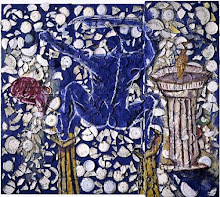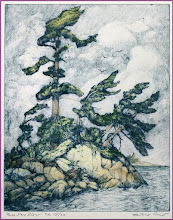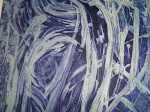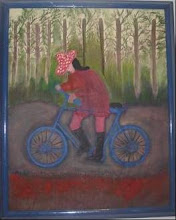My son is almost grown, which means that the opportunities for volunteering as a parent chaperone are fast disappearing. When my boy was in elementary school, and I was elected secretary of the PTA (not by choice, mind you, but only because no one else was willing to do it), it seemed that every other week I was being tapped to help out in the art class or take over the after-school French class. Back then, in the talc mines of motherhood, when I was complaining about all the minutes I had to take and the cupcakes I had to bake, I never imagined that I would pine for the long afternoons of herding noisy children through museums.
A friend once described me as a hopeless passeist, which means I’m in love with the past simply because it is past, and I can lose myself in a sentimental Proustian swoon over any and all of my yesterdays, however ordinary, simply because they are gone.
All of which is preface and prolegomena to the cameo of your humble blogger wandering like an English sheepdog behind a gaggle of eighteen ninth-graders as they cavorted along the paved walkways of Amherst College, preparing to lay siege to its rust-colored Natural History Museum. Their teacher, Mr. Weems, had warned that they were to be silent as fossils—in fact, if they spoke above a whisper in the corridors, they would never be allowed in the museum again (ill-behaved middle schoolers from another school were responsible for such draconian policy).
As our group shuffled into the high-ceilinged hall of dinosaurs, my son and his classmates were divided into groups, shepherded into elevators, and led to their designated floors. Each student was expected to stand before his or her chosen mineral, and produce a detailed ink drawing on his or her sketchpad.
There were three parent volunteers, including myself. (When we set off from the Hartsbrook school’s parking lot, we had only two but a last-minute cell phone call from the bus scared up Sarah, a harried mother of five who had completely forgotten about having signed on for her tour of duty.) Paul was assigned to patrol the first floor; Sarah was stationed on the second floor; while I became the chatelaine of the third floor, peering over the shoulders of four ninth-graders as they studied their quartz, garnet, topaz, and copper.
My charges were as silent as Tutankhamen’s tomb-mates (my son was presumably equally mum sketching calcite on the second floor), which meant I could relax and admire the sapphire hills of the Holyoke Range from the open offices of the Amherst College geology profs as well as marvel at the queerly named specimens of riebeckite, kyanite, glauconite, cavansite, and sodalite, all of which were displayed and identified in the large glass cases lining the walls. Who knew that there were so many rocks from places near and far with so many declensions of blue? Who knew that it was possible to feel, swanning up and down the hushed wooden floors, as clueless as a medieval peasant? Ah, to barge into the offices of one of those geology profs, and be instructed in the mysteries of plate tectonics!
And then I saw it—the stone that stilled all neuronal pitter-patter. It was at the end of the corridor in a massive tri-level display case across from the janitor’s office and catty corner to the women’s room. The rock was massive, big as the helmet of Pericles, and rivered and pockmarked with blues and greens. The identifying card explained that it was a combination of azurite and malachite, both of which are oxidized forms of copper. The rock hailed from Bisbee, Arizona, and its technical name was a medley of uppercase C’s and O’s and lower case 2s and 3s.
(In the next few days, I would research azurite, learning that it is also called Chessylite, after a mine in Lyons, France, as well as Blue Bice or simply Bice, which comes from the Old French word, Bis, for gray. Azurite derives from the Persian, lazhward, which is an area in the present-day Iranian desert known for its deposits of lapis lazuli, another deep blue stone with which azurite was often confused. Lapis lazuli, which is Latin and means stone of azure, derives from the metamorphic rock of lazurite. Coarse grains of azurite were commonly used by medieval and Renaissance painters; Vermeer and Raphael were both especially fond of azurite. Not as bright and blue as aquamarine, azurite was cheaper and more plentiful.)
“Gather me into the artifice of eternity,” William Butler Yeats once wrote in his poem, “Sailing to Byzantium.” That line had always mystified me. How could eternity be a constructed or even a reconstructed experience? But hovering in the circles of midday light beside the azurite, I suddenly got it. The rock, its blues and greens making prismatic patterns such as one sees when looking through a kaleidoscope, hardly looked like it was extracted from anyplace as humble as the Mule Mountains of Bisbee, Arizona, but as if its crystals were hammered into form by Hephaestus himself.
Then, as if refracting the arc of my son’s childhood, Mr. Weems appeared at my side to whisper that it was time to go. I led my charges to the elevator and down to the outdoor terrace for the obligatory headcount. The mood in the noonday sun was festive, and after all the gangly teenagers were accounted for, we marched back to the bus, the three parent chaperones piling into Paul’s van, with my son and one of his classmates, Sean, settling in the back seats.
On the return to school, we talked of things lapidary. Paul praised the diamonds from Brazil on the first floor, and I recalled the many specimens of quartz, including the purple amethyst. Who knew that the semi-precious stone was a type of quartz? Sean explained that quartz was actually very plentiful, covering 20 percent of the lithosphere.
What’s the lithosphere, I asked, feeling, once again, stupider than a baker, butcher, and candlestick maker. The fifteen-year-old patiently explained that it was another name for the outer surface of the earth’s crust. Oh, I said, thinking that there should be a word—sheeposphere?—for the region a parent enters when her son and his peers prove that they are smarter.
Then the talk segued to the high school prom, which was scheduled for Saturday night, who was taking whom, what the boys were planning to wear (the theme was under the ocean) and whether the services of parent chaperones would be needed. Sarah, with her five children, was an expert in the protocol of proms past, and explained that the entire faculty turned out to chaperone, and that parents’ services were not required, save for the dropping off and the picking up.
The following evening, when my boy, freshly shaven and dressed in his father’s tux, bounded out the door to be ferried by another parent to the prom, I felt a bit teary-eyed. But within the hour, I was back on Google, researching the history of azurite.
Some weeks later, I returned to the museum to wander lonely as a cloud through the empty corridors, riding the elevator to the third floor to visit what I have come to regard as my specimen of azurite, which was even lovelier the second time glimpsed, its rivulets of blues and greens sure to move future generations of schoolchildren and their parents.
All posts copyright© 2010. All rights reserved. No part of this blog may be reproduced or distributed without attribution and/or permission of the author
Introducing Frida von Zweig
3 years ago








